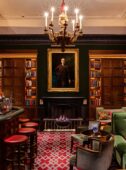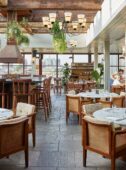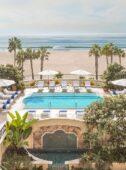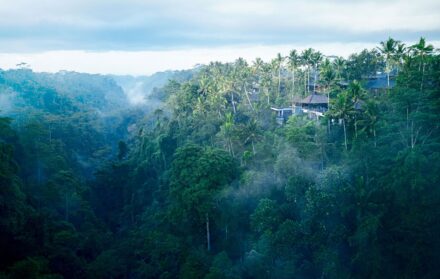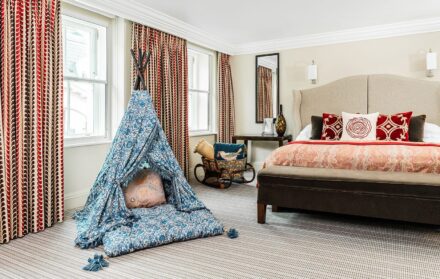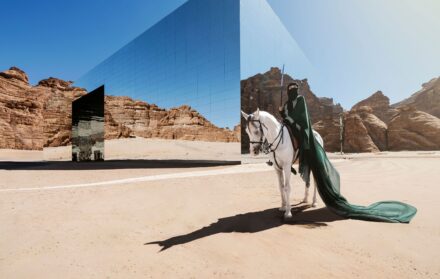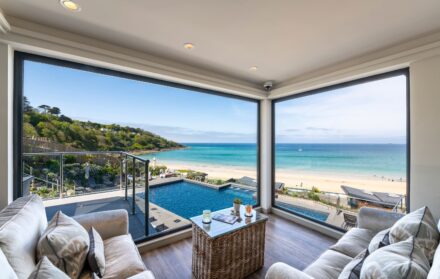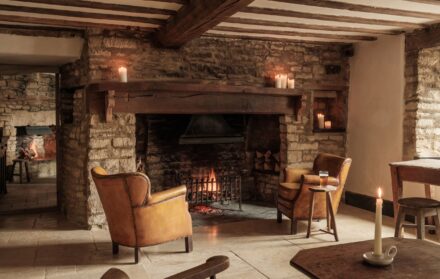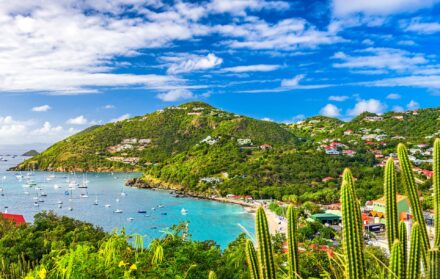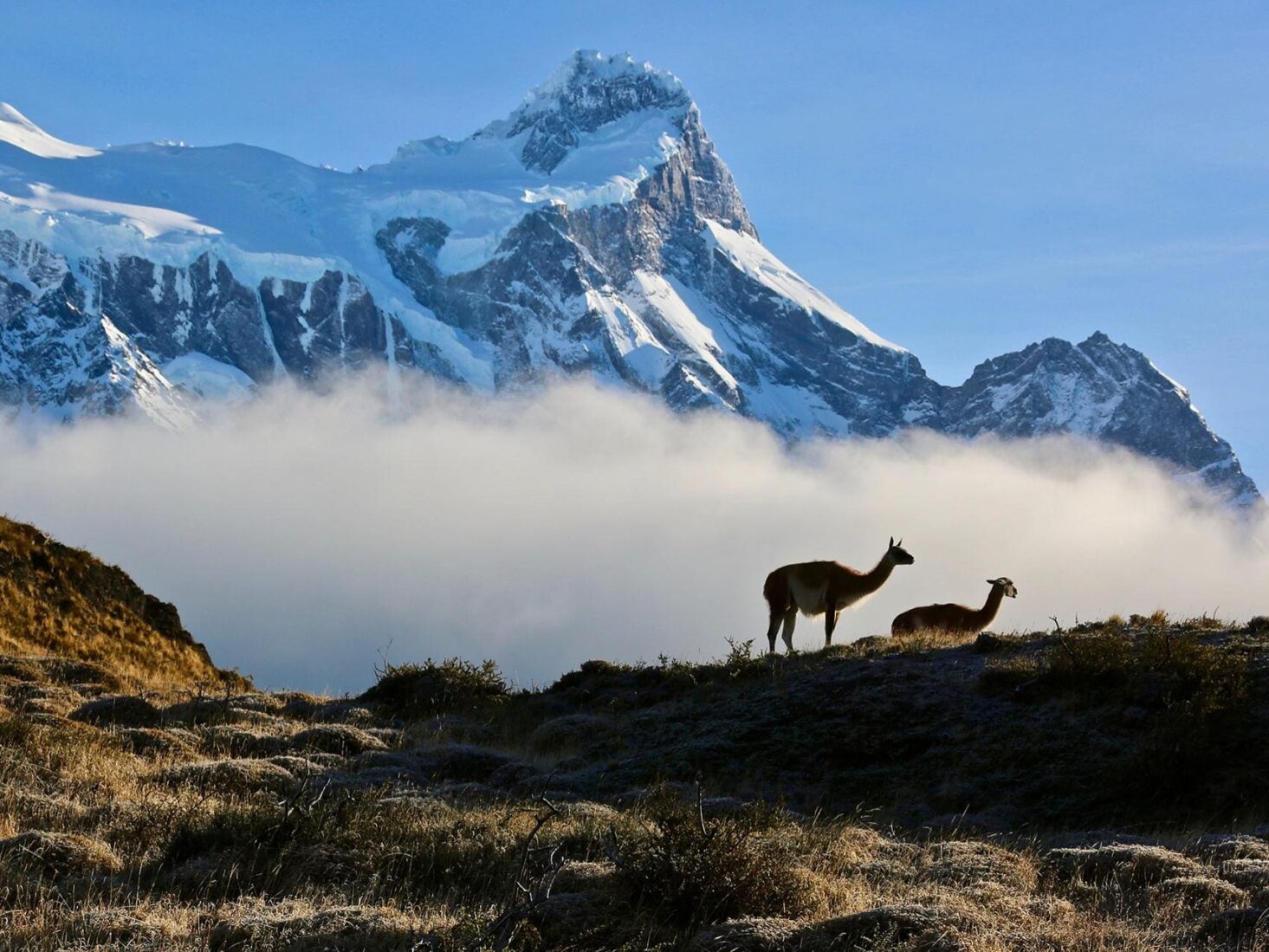
Patagonia: A Trip of a Lifetime in South America’s Southern Frontier
Wondrous, unspoiled nature and five-star accommodation in Patagonia with Abercrombie & Kent
My horse has to break the icy surface of a river with his hoof before we can cross to the other side. It takes more than a gentle tap. A few dedicated thumps are required before the glassy crust cracks to reveal clear flowing water beneath. Tentatively, he wades in and, once his footing is sound, pushes through to the other side. When it comes to such physical pursuits, I am usually not the bravest, but I’m riding out with two derring-do gauchos, and I’m pleased I signed and saddled up. It feels as though I’ve gatecrashed a nature documentary. Soaring, serrated mountains bite too-blue-to-be-true skies, flamingos show off their pink plumage in a pristine lake and hares seem to be playing mad games of hopscotch in the pampas. To complete the scene, cue an Andean condor, the world’s largest raptor, wheeling overhead. Presumably he’s directing the drone footage. And cut…

I’m in the Torres del Paine national park in Chilean Patagonia, part of that great wilderness at the southern end of South America, a region that extends far into Argentina to the east. Isolated by mountains, ice fields and oceans, Torres del Paine encapsulates all that is untamed and far-flung. Even if you’ve never set foot in the place, just the mention of its name conjures a sense of romantic drama, with the towering Andes, glaciers and grasslands, fierce winds and endless roads, some of which appear to lead to nowhere. In order to place Torres del Paine into geographical context, before I left for Chile I took the chance to pinpoint where I was going on a giant globe. Put it this way, I had to lie on the floor. It really is ‘next stop, Antarctica’.
Having just marked 200 years of independence, Chile is currently piquing tourist interest as never before. Notably, five new national parks have just been created, preserving vast tracts of Patagonia and representing the culmination of 25 years of work by the late US philanthropist Douglas Tompkins, founder of The North Face and Esprit brands, and of his wife, Kristine McDivitt Tompkins, CEO of Tompkins Conservation. Her recent handover of more than one million acres is considered to be the largest donation of private land to a government. With the Chilean president pledging another nine million acres, the country is cementing its place as one of the global leaders in conservation.

While I have been drawn by the call of the wild – and more specifically, to spot the pumas that venture further down the mountains during winter in search of food – I fully admit I am not one to eschew luxury. Hence I’m staying at one of the Explora lodges that specialise in offering supremely stylish and comfortable accommodation in some of South America’s most remote regions.
I arrive at night in the pitch-black – just before a late supper and the chance to put my name down for horse riding – so when I climb under a meringue-coloured duvet I have no notion of what lies outside the window. At dawn I raise the curtain on a stop-me-in-my-tracks vista. Set on serene Lake Pehoé, the white, clean-lined lodge looks out to the Paine Massif, home to the impressive torres – three immense towers of granite – that give the park its name. Move through the wooden interiors to the restaurant and there is the Salto Chico waterfall swirling beneath you. If there is a better view from a hotel, I’ve yet to see it. And if there is a better place to sip a pisco sour, I’ve yet to drink in it.

Sure, it’s a long schlep to reach this Patagonian nirvana. After your flight to Santiago, the city that bookends many a trip in Chile, there’s a three-and-a-half-hour flight south to Punta Arenas. Then there’s around a four-and-a-half hour journey by road from the airport to the lodge. But when you get to the Explora lodge, goodness it’s worth it. From the knowledgeable guides and excellent menus – think pink lamb and southern king crab – to the biodegradable slippers you are assured of a certain level of easy-going luxe. There’s also a heated indoor pool and sauna and there are open-air Jacuzzis. Such cocooning is no mean feat given you are slap bang in the middle of a half-a-million-acre park at the end of the world.
As expected, pumas are high on most guests’ must-sees. But as I soon learn, they are elusive creatures and blend in rather well with their surroundings. I am told that we might be lucky to see them anywhere on our travels, and if we do we should remain calm, keep a respectful distance and listen to safety instructions from our guide. Fingers crossed, then.
I’m here in the winter, which runs from June to early September; unsurprisingly, summer is more popular. Yet every season reveals its own beauty and the weather is always unpredictable. Warm sunshine can turn into an intense squall, soft rain into an eerie mist. But nothing stops the hiking from the lodge.

One of my favourite excursions is to Nordenskjöld Lake, a mirror of tranquillity set against the spectacular Cuernos del Paine peaks, so-called because these jagged columns of rock resemble horns, jutting skywards with dramatic defiance. All around us are guanacos, the region’s signature animal and the tourist board’s poster child. Guanacos are related to the camel and have long fluffy necks and Max Factor eyelashes. There are so many, I practically have to push through them to progress. But a gaggle of guanacos means there are no pumas here.
Pumas are not lurking around Lake Sarmiento either, another majestic site where the sound of cracking ice suddenly splits the air in two. We drop down onto a beach where rocky formations of calcium look like installations at the Tate.

Exploring this spectacular terrain, which was declared a Unesco Biosphere Reserve in 1978, is addictive. Explora offers more than 40 excursion options that meet differing fitness and experience levels, with some following parts of the W Circuit, a renowned trail that requires at least five days of trekking if you were to go the whole 50 or so miles (or 80 kms). The same variety is afforded on horseback. Opt for a Brighton beach amble or go hell for leather with the gauchos (they may love their signature berets but they ensure everyone wears a riding helmet).
But I’m here for the pumas. I’m told one of the best chances is to take the Aonikenk hike. So I do. Twice. It’s a cool outing, even cooler because I plough on in the snow at dawn and, as the sun burns through, the whole frosty scene resembles a fairyland. We also get to see a cave with a couple of 4,000-year-old paintings left by the indigenous Aonikenk people. On my repeat hike, I come across some filmmakers who are working on a documentary about pumas. Have they seen any this morning? Nope.

Back in the van, I realise that I’ve pretty much exhausted my chances of seeing a puma. I feel slightly dejected. I spend 20 minutes of the journey looking at my boots. Then I hear a voice in my head (let’s say it’s the god of the big cats). It whispers, “You won’t see a puma staring at the floor. Look up. Look up.” And there, way in the distance, I swear I catch a glimpse of a sandy-coloured animal zigzagging the slate-grey mountain face.
I get bossy (it can happen). “Stop the van. No, actually go forward. He’s going over that ridge and will come down.” We turn the corner. We stop the van. Nada. Have I a made a touristy fuss for naught? It’s so silent, you can hear an icicle drop. Then he appears, picking and padding his way over the rocks. Mighty and muscular, he stops awhile to gaze at us, raising his chin as if fulfilling his contract. Then he crosses our path and he’s off. The puma has landed. I head back to Explora, oxygen-enhanced and overexcited. Patagonia, on so many levels, has delivered.
Santiago Panel
Taking a trip to Patagonia from London usually means a stopover in the Chilean capital, Santiago. Each barrio (district) has its own distinct character and there are museums, markets, buzzing bars, great restaurants and grand buildings aplenty.

Where to stay: Hotel Lastarria is a splendid boutique hotel in the bohemian neighbourhood of Lastarria, which offers easy access to the city’s attractions. Built in 1927, it has an air of elegance and a contemporary-chic interior. With only 14 rooms, this refurbished mansion feels intimate. The Deli Lounge serves breakfast, tasty plates, snacks and delicious wines, and overlooks a quaint inner courtyard with a small pool.
Meet locals in style: Abercrombie & Kent has created a new experience called ‘Be My Guest’ that really puts you at the heart of Chilean life in a single evening. Dining with locals, usually at a private home, you might be in the company of anyone from a local artist to a young dynamic Chilean business couple. Salud!

View the street art: Santiago is renowned for its street art, which is far from random graffiti. Ask Abercrombie & Kent to organise a guided tour with a bona fide artist who can take you around areas such as the San Miguel barrio district, with its Museo a Cielo Abierto (open-air museum) featuring many murals. Also worthy of a visit is Barrio Yungay, full of brightly coloured historic houses and many works of street art.
Take a fabulous day trip: Wineries don’t come much more picturesque and welcoming than Santa Rita, just 45 minutes from Santiago. It not only produces international award- winning wines, but offers plenty to see and do. Enjoy the old estate house (which is now the Casa Real Hotel), the beautiful gardens, wine tours and tastings in the historical cellars, the Andean Museum in the grounds and the Doña Paula Restaurant, which is also a national monument.
Abercrombie & Kent (020 3814 0760) offers eight nights from £5,500pp including international flights with British Airways, internal flights, transfers, sightseeing and accommodation including a five-night stay at Explora Patagonia on a full board basis with daily explorations, abercrombiekent.co.uk
